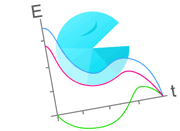We do not know how much patients with ME/CFS vary over the course of a year, and have very little reliable information about their chances of full recovery. Without this information, it is essential to have a proper control group with any study involving ME/CFS. (Indeed a proper control group is considered a basic essential of any scientific study.) So little is understood of the mechanisms of ME/CFS that ignoring such a factor is scientifically inappropriate. Unfortunately, the PACE trial did not have such a control group, so with weak average results, it is hard to assess the contribution that natural variations and a reluctance to admit wasting time and energy may have had on them.
We decided to collect information from people that we knew with ME, so that we could have some feel for the natural variations that we are talking about. We asked if they would classify themselves as mild, moderate or severe (using the classification used by the Goudsmit study mentioned in 3:Chalder) where:-
■ Mild was defined as being able to lead a reasonably normal life;
■ Moderate was defined as not being able to work, and being able to do less than 50% of what the person could do before they became ill;
■ Severe was defined as being able to do less than 25% of what the patient could do before they became ill, and being dependent on other people for activities such as cooking and shopping.
We asked them to complete the 11 point Chalder questionnaire for how they felt today, then repeat it for when (or if) they had gone through a bad patch lasting at least a week during the previous year, and again for a good patch lasting at least a week.
Obviously this survey would not stand up to proper scientific scrutiny: it is not designed to do that. The appropriate method would involve monitoring each patient's health over the course of a year and applying certain controls and checks, but our data should give a good indication as to whether variability could be a significant factor. The number and consistency of our results are reassuring.
|





